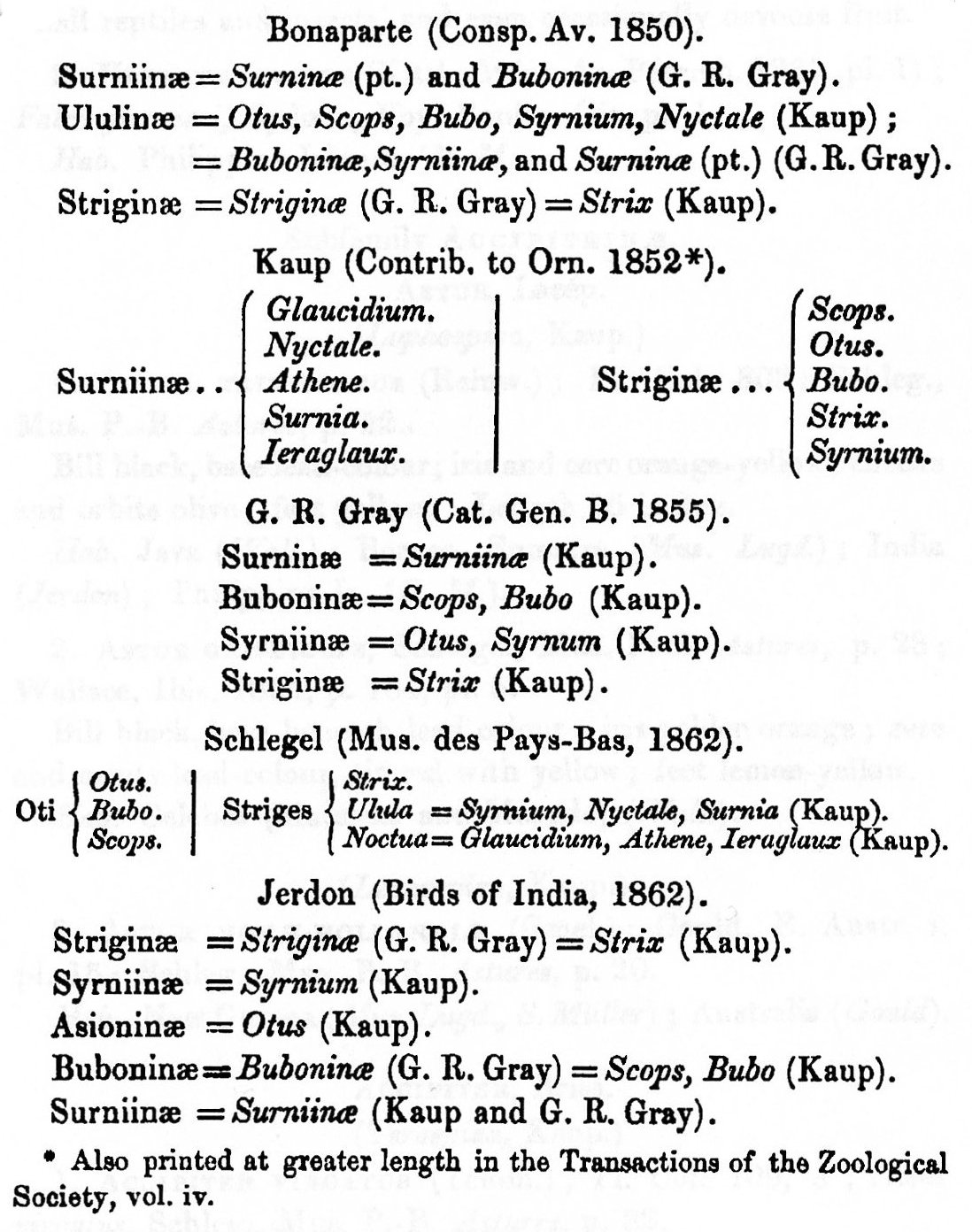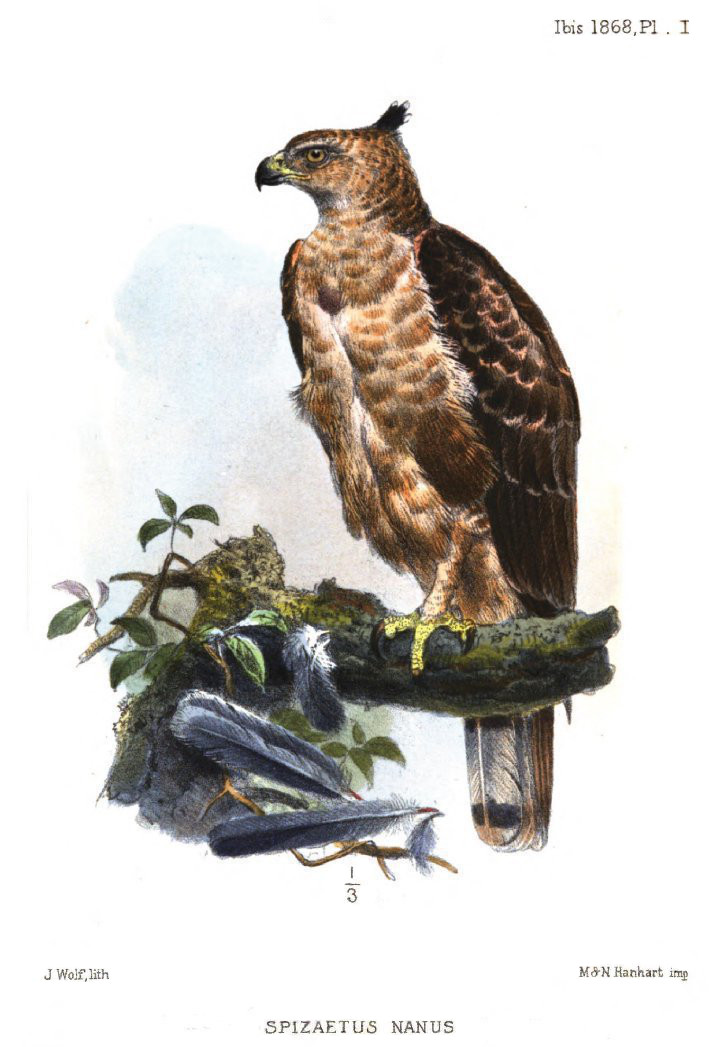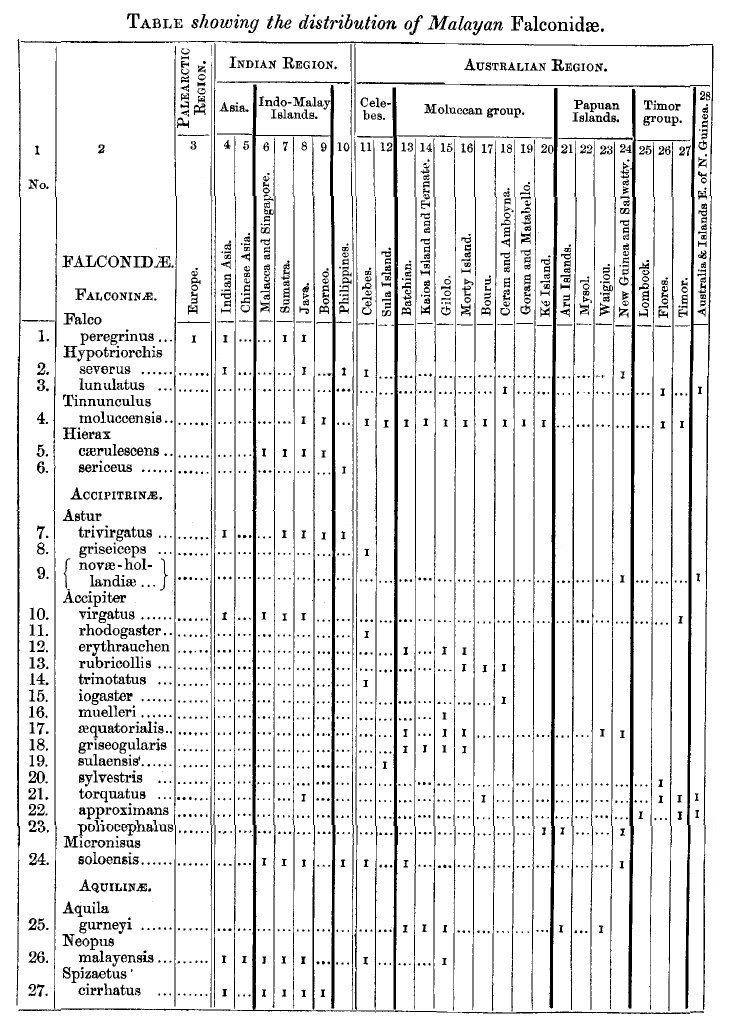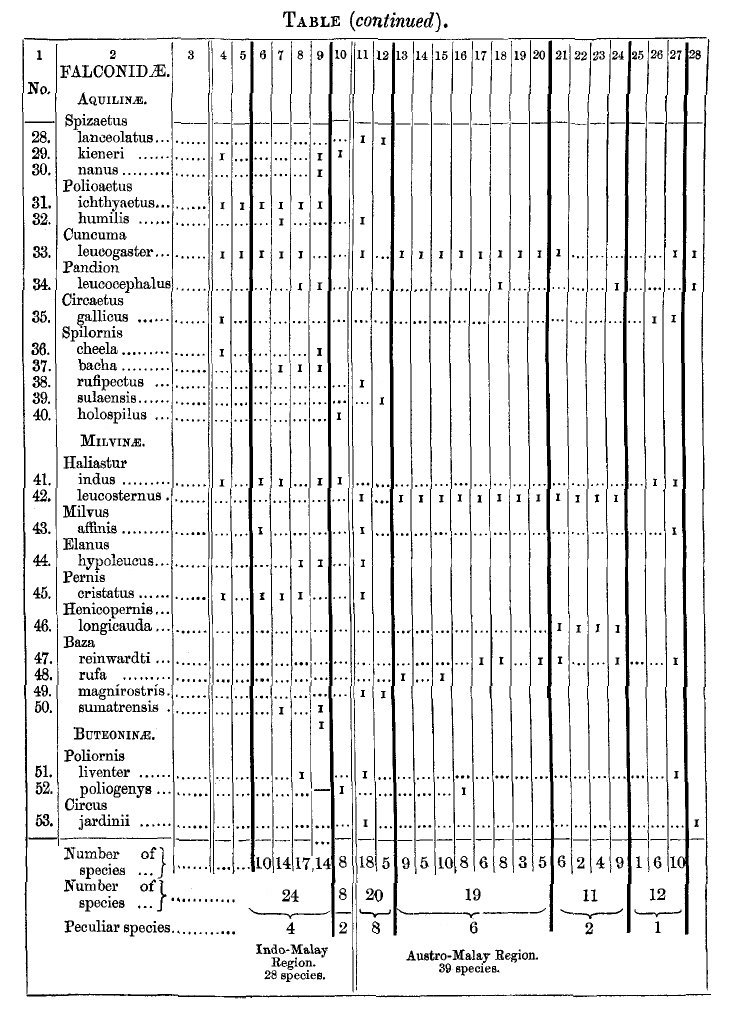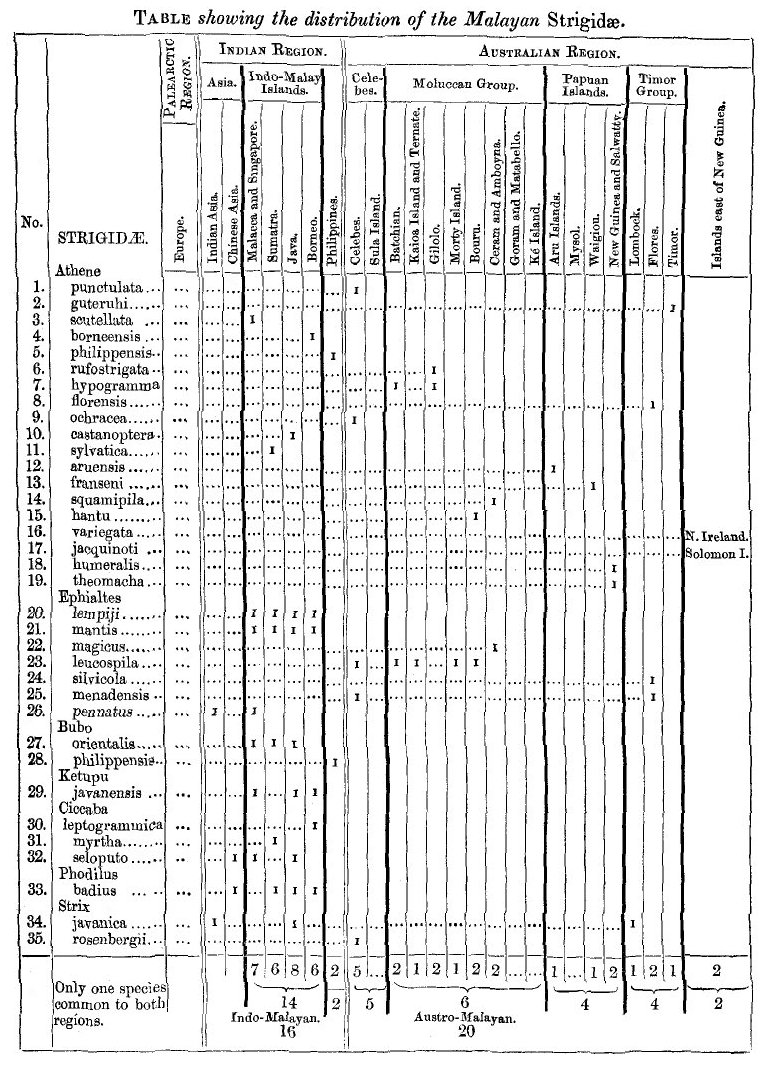|
Russel Wallace : Alfred Russell Wallace (sic)
My answer is, that Professor Schlegel's works above enumerated do not give a complete list of the Malayan Accipitres; for the first is a Museum Catalogue, the second a Colonial fauna; [[p. 2]] and, therefore, all species which do not exist in the Leyden Museum and which inhabit the Malay Archipelago, Northern Borneo, the Philippine Islands, Eastern New Guinea, and the islands extending thence to the Solomon Islands do not find a place in his works, although they undoubtedly form a part of the fauna of the Malay Archipelago. In the next place, I possess an extensive collection of this group formed by myself, comprising seventy-two out of the eighty-seven known species, and containing fine series of many of the species accurately labelled with locality and sex, with notes of the colours of the soft parts, which information I desire to make known in a connected form. Lastly, I differ in many points from both Prof. Schlegel and Dr. Kaup, and wish to explain the reasons why I differ from such eminent men. With the exception that Vultures are entirely absent, birds of prey are tolerably plentiful in the Archipelago, the total number of species being greater than those of India as restricted by Dr. Jerdon. This large number seems to be chiefly due to the breaking-up of the district into a vast number of islands, most of which were separated at a more remote epoch than that of the origin of many existing species, while some date from a high geological antiquity. Closely allied representative species, therefore, abound and swell the total amount, although in any one island or locality the number to be obtained is very small. The average number of Falconidæ found in an island is ten, of Strigidæ three. Java contains the largest number, possessing seventeen Hawks and eight Owls; Celebes comes next, with the same number of Hawks, but only five Owls; whereas in many districts of India, equal in extent to one of these islands, double this number of species would probably be obtained. In Ceylon Mr. Layard obtained twenty-three Hawks and seven Owls. Of the subfamilies, the true Hawks (Accipitrinæ) are the most abundant, numbering eighteen species; next come the Eagles (Aquilinæ) with sixteen species, the Kites (Milvinæ) with ten species, the Falcons (Falconinæ) with six species, and the Buzzards and Harriers (Buteoninæ) three species. Taking the groups of islands, the number of species diminishes pretty regularly from west to east. The Indo-Malay group (Malacca, [[p. 3]] Sumatra, Java, and Borneo) has thirty-eight species, the Philippines (no doubt imperfectly explored) ten, the Celebes group twenty-five, Moluccan group twenty-five, Timor group sixteen, Papuan group fourteen. Yet, owing to the larger number of islands, and the richness of Celebes as compared with the Philippines, the Austro-Malayan Region, on the east, possesses more species than the Indo-Malayan Region on the west, the former having fifty-eight, the latter forty-four species. The greater power of flight and more roaming habits of the diurnal as compared with the nocturnal birds of prey is well indicated by the fact that, while fourteen Falconidæ are common to the Indian and Australian regions of the Archipelago, only a single Owl has the same range--which is very suggestive of the natural character of these divisions. But few of the genera have a limited range. Hierax is strictly confined to the Indian region, and Spizaetus, Polioaetus, and Spilornis only pass beyond it into Celebes. This island exhibits its usual characteristic of a number of peculiar species, having (with the Sula Islands) eleven out of twenty-five which are found in no other island, an unusually large number in this wide-roaming group of birds. It also seems to have some power of conferring on its species a peculiar facies, similar to that which I have already noticed as occurring among the Papilionidæ (Trans. Linn. Soc. xxv. pp. 1-71). The Celebes varieties of Pernis cristatus and Spizaetus lanceolatus are coloured exactly alike, with a brown spotted band across the breast; and there is a similar style of coloration in Spilornis rufipectus and S. sulaensis, as well as in Baza magnirostris--all species peculiar to the Celebes group. Truly this island is a mystery hard to be understood--one of Nature's best riddles, which no man can find out! The classification of the Birds of Prey is so difficult that hardly two authors entirely agree upon it. As regards eastern genera, I think Dr. Jerdon, in his 'Birds of India,' has given the most natural arrangement; and I mainly follow him in the Falconidæ. It appears to me very unnatural to break up the large and powerful Eagles of the genera Circaetus, Spilornis, and Spizaëtus among the Buzzards and Hawks, as is done by Bonaparte and Prof. Schlegel, because we thereby destroy the [[p. 4]] distinctive features of those groups. Haliastur, however, seems much better placed among the Kites, with which it agrees in all essential characters. Schlegel places Aquila gurneyi as a Spizaetus among his Astures, and thus groups one of the most massive of the Eagles in the same subfamily with the most delicate little Sparrow-Hawks, such as Accipiter virgatus and A. rhodogaster. In the Owls the confusion and uncertainty is still greater, as will be seen by the following series of classifications.
[[p. 5]] Amid these conflicting opinions, and as I have to deal with very few genera, I think it best to arrange the Owls in a simple series, beginning with the small species (Athene and Ephialtes) and ending with the genus Strix. Order ACCIPITRES, Linn. Family FALCONIDÆ. Subfamily FALCONINÆ. FALCO, Linn. FALCO PEREGRINUS, Gmel. Hab. Java (Schlegel), Samatra (Raffles), India (Jerdon). HYPOTRIORCHIS, Boie. 1. HYPOTRIORCHIS SEVERUS (Horsf.); F, aldrovandi, Reinw.; Temm., Pl. Col. 128. Hab. Macassar, ♂, Salwatty, ♀ (Wall.); Java (Mus. Lugd.); Philippine Isles, North India
(Jerdon). 2. HYPOTRIORCHIS LUNULATUS (Lath.); F.frontatus, Gould, B. Aust. i. pl. 10; F. lunulatus, Gould, Handb. B. A. i. p. 29. Hab. Flores (Wall.); Ceram (Mus. Lugd.); Australia (Gould). TINNUNCULUS, Vieill. TINNUNCULUS MOLUCCENSIS, Homb. & Jacq., Voy. Pôle Sud, pl. i. f. 2; Falco moluccensis, Schleg., Mus. P.-B. Falcones, p. 28, Valkv. Nederl. Ind. pl. i. fig. 3, 4, 5. Hab. Celebes, all the Moluccas, Flores, Timor, and Goram (Wall.); Borneo (Mus. Lugd.);
Java (De Bocarmé). [[p. 6]] Varies considerably in the colour and markings of the tail, some specimens from Celebes and Timor showing an approximation to T. alaudarius. HIERAX, Vigors. 1. HIERAX CÆRULESCENS (Linn.); Pl. Col. 97; Schleg., Mus. P.-B. Falcones, p. 33. Hab. Malacca, Sumatra (Wall.); Borneo, Java (Mus. Lugd.). 2. HIERAX SERICEUS (Kittl., Mém. Ac. Pétersb. 1835, pl. 1); Falco gironieri, Eydoux, Voy. Bonite, Ois. pl. 1. Hab. Philippine Islands (B.M.). Subfamily ACCIPITRINÆ. ASTUR, Lacép. 1. ASTUR TRIVIRGATUS (Reinw.); Pl. Col. 303; Schleg., Mus. P.-B. Astures, p. 22. Bill black, base lead-colour; iris and cere orange-yellow; cheeks and orbits olive; feet yellow. Length 15 inches. Hab. Java (Wall.); Borneo, Sumatra (Mus. Lugd.); India (Jerdon); Philippine Is. (B. M.). 2. ASTUR GRISEICEPS, Schlegel, Mus. P.-B. Astures, p. 23; Wallace, Ibis, 1864, p. 184, pl. 5. Bill black, base beneath lead-colour; iris golden orange; cere and orbits lead-colour, tinged with yellow; feet lemon-yellow. Hab. Celebes (Macassar and Menado) (Wall.). (Leucospiza, Kaup.) 3. ASTUR NOVÆ-HOLLANDIÆ (Gmel.); Gould, B. Austr. i. pl. 15; Schleg., Mus. P.-B. Astures, p. 20. Hab. New Guinea (Mus. Lugd., S. Müller); Australia (Gould). ACCIPITER, Briss. 1. ACCIPITER VIRGATUS (Temm.); Pl. Col. 109, ♂; Nisus virgatus, Schleg., Mus. P.-B. Astures, p. 32. [[p. 7]] Bill black, lead-colour at base; iris and cere yellow; feet pale orange-yellow. Hab. Malacca, Timor (Wall.); Java, Sumatra (Mus. Lugd.); India (Jerdon). 2. ACCIPITER RHODOGASTER (Schleg.); Nisus virgatus rhodogaster, Schleg., Mus. P.-B. Astures, p. 32; N. rhodogaster, Schleg., Valkv. Nederl. Ind. pl. xii. fig. 5, 6. Bill black; cere dusky yellow, feet yellow; iris bright chrome-yellow. Hab. Celebes (Wall.) 3. ACCIPITER ERYTHRAUCHEN, G. R. Gray, P. Z. S. 1860, p. 344; Nisus erythrauchen, Schlegel, Valkv. Nederl. Ind. pl. xiii. fig. 1 (?), 3, 4; Uraspiza erythrauchen, Kaup, P. Z. S. 1867, p. 177. Hab. East Gilolo, ♂ (Wall.); Batchian, ♂, Morty, ♀ (Mus. Lugd.). 4. ACCIPITER RUBRICOLLIS, Wall., P. Z. S. 1863, p. 21, pl. 4; Nisus cirrhocephalus ceramensis, Schleg., Mus. P.-B. Astures, p. 39; N. erythrauchen, Schleg., Valkv. Nederl. Ind. pl. xiii. fig. 2; Uraspiza erythrauchen, Kaup, P. Z. S. 1867, p. 177. Bill black, lead-colour at base; iris golden-yellow; cere and feet yellow. Hab. Bouru, Morty Is.? (Wall.); Ceram (Mus. Lugd.). (Erythrospiza, Kaup.) 5. ACCIPITER TRINOTATUS, Bp., Consp. Av. i. p. 33; Nisus trinotatus, Schleg., Mus. P.-B. Astures, p. 45; Valkv. Nederl. Ind. pl. xix. fig. 1-3. Bill and cere above the nostrils black; cheeks and orbits orange-yellow; feet deep orange-yellow; iris chrome-yellow. Hab. Celebes (Macassar and Menado) (Wall.). 6. ACCIPITER IOGASTER (S. Müll.); Falco iogaster, Müll., Verh. Nederl. Overz. Land- en Volkenk. p. 110; Hombr. & Jacq., Voy. au Pôle Sud, pl. ii.; Nisus iogaster, Schleg., Mus. P.-B. Astures, p. 43, Valkv. Nederl. Ind. pl. xviii. Bill black; iris deep orange-yellow; cere, eyelids, and feet orange. Hab. Ceram, Amboyna (Wall.). [[p. 9]] 7. ACCIPITER MUELLERI, Wall., P. Z. S. 1865, p. 475; Erythrospiza griseogularis (pt.), Kaup, P. Z. S. 1867, p. 175; Nisus cruenius, Schleg., Valk. Nederl. Ind. pl. xiv. & xvi. Bill black, bluish at base; cere and feet bright yellow. Hab. Gilolo (Wall.). 8. ACCIPITER GRISEOGULARIS (G. R. Gray, P. Z. S. 1860, p. 343); Nisus cruentus, Schleg., Mus. P.-B. Astures, p. 41, Valkv. Nederl. Ind. pl. xiv.-xvi. Hab. Batchian, Gilolo, Ternate, Morty Is. (Wall.). [[p. 10]] 9. ACCIPITER ÆQUATORIALIS, Wall., P. Z. S. 1865, p. 474; Erythrospiza griseogularis (pt.), Kaup, P. Z. S. 1867, p. 174; ? Astur henicogrammus, G. R. Gray, P. Z. S. 1860, p. 343, juv. Bill black; cere, eyelids, and feet orange-yellow; iris golden orange-yellow. Hab. Batchian, Gilolo, Morty Is., Waigiou, Salwatty (Wall.). (Uraspiza, Kaup.) 10. ACCIPITER SULAENSIS (Schleg.); Nisus sulaensis, Schleg., Valkv. Nederl. Ind. pl. xvi. fig. 3, 4; Uraspiza sulaensis, Kaup, P. Z. S. 1867, p. 176. Hab. Sula Islands, Ceram ? (Mus. Lugd.). 11. ACCIPITER SYLVESTRIS, Wall., P. Z. S. 1863, p. 487; Uraspiza torquata (pt.), Kaup, P. Z. S. 1867, p. 176. Hab. Flores (Wallace). 12. ACCIPITER TORQUATUS (Temm.); Pl. Col. 43, 93; Astur cruentus, Gould, B. Austr. i. pl. 18; Accipiter cruentus, Wall., P. Z. S. 1863, p. 484 (ex Timor); Nisus torquatus et N. cruentus, Schlegel, Mus. P.-B. Astures, pp. 39, 40. Hab. Timor, Flores, Bouru (Wall.); Java, Sumbawa (Mus. Lugd.). 13. ACCIPITER APPROXIMANS (Vig. & Horsf.); Gould, B. Austr. i. pl. 17. Hab. Lombock (Wall.); Timor (Mus. Lugd.). 14. ACCIPITER POLIOCEPHALUS, G. R. Gray, P. Z. S. 1858, p. 170; Sclater, Ibis, 1860, pl. x.; Nisus poliocephalus, Schleg., N. T. D. iii. p. 326. Hab. Aru Is., ♀, Salwatty, ♂, Dorey, ♂ juv. (Wall.); Ké Is. (Mus. Lugd.). MICRONISUS, G. R. Gray. (Tachyspiza, Kaup.) MICRONISUS SOLOENSIS (Horsf., Trans. Linn. Soc. xiii. p. 137); Falco cuculoides, Temm., Pl. Col. 110, 129; Nisus soloensis, Schleg., Mus. P.-B. Astures, p. 44. [[p. 13]] Hab. New Guinea, Batchian, Sumatra, Malacca (Wall.); Java, Celebes, Philippine Is.
(Mus. Lugd.). Subfamily AQUILINÆ. AQUILA, Briss. AQUILA GURNEYI, G. R. Gray, P.Z.S. 1860, p. 342, pl. 169; Spizaetus gurneyi, Schleg., Mus. P.-B. Astures, p. 14. Hab. Batchian, Waigiou (Wall.); Aru Is., Ternate, Gilolo (Mus. Lugd.). NEOPUS, Hodgs. NEOPUS MALAYENSIS (Reinw.); Pl. Col. 117; Aquila malayensis, Schlegel, Mus. P.-B. Aquilæ, p. 11. Hab. Java, Sumatra, Celebes, Ternate (Mus. Lugd.); India, Burmah (Jerdon). SPIZAETUS, Vieill. 1. SPIZAETUS CIRRHATUS (Gmel.); Falco limnæetus, Horsf., Trans. Linn. Soc. xiii. p. 138; F. caligatus, Raffles (tom. cit.), p. 278; Astur unicolor, Temm., Pl. Col. 134; Falco niveus, Temm., Pl. Col. 127; Nisaetus alboniger, Blyth, Madr. Journ. xxxi. p. 145; Spizaetus cirrhatus, Schleg., Mus. P.-B. Astures, p. 9, Valkv. Nederl. Ind. p. 53, pl. vi. vii. Hab. Java, Penang (Wall.); Sumatra, Borneo (Mus. Lugd.); India (Jerdon). 2. SPIZAETUS LANCEOLATUS, Bp., Consp. Av. i. p. 29; S. cirrhatus (pt.) Schlegel (ut suprà). Hab. Celebes (Wall.); Sula Is. (Mus. Lugd.). 3. SPIZAETUS KIENERI, Gervais, Mag. de Zool. 1835, Ois. pl. 35; Schleg., Mus. P.-B. Astures, p. 11. Hab. Borneo (Wall.); Philippines? (Mus. Lugd.); India (Jerdon). 4. SPIZAETUS NANUS, sp. nov. (Plate I.) Supra fuscus, subtus albo-rufescens; alis rotundatis brevibus; caudâ trifasciatâ; digitis parvis. Above brown, the head paler, with a black occipital crest, white-tipped; wings rounded, the fourth and fifth quills longest; tail rather long, smoky-brown, with three blackish bands, one at the extremity and two towards the base; beneath white, tinged with rufous; a dark patch over the eyes and lores. Total length 19 inches; wing 11 inches, the tip 2 inches; tail 8.5 inches; tarsus 2.625 inches; middle toe 1.375 inch, inner toe .86 inch. The middle toe is feathered nearly to the first joint. Hab. Borneo. POLIOAETUS Kaup. 1. POLIOAETUS ICHTHYAETUS (Horsf., Trans. Linn. Soc. xiii. p. 136); Haliaetus ichthyaetus, Schlegel, Mus. P.-B. Aquilæ, p. 17. Hab. Malacca, Sumatra (Wall.); Borneo, Java (Mus. Lugd.); Bengal, Burmah (Jerdon). 2. POLIOAETUS HUMILIS (Schlegel & Müller,Verh. Ned. Overz. Vög. pl. 6); Ichthyaetus nanus, Blyth, J. A. S. B. 1842, p. 202; Haliaetus humilis, Schleg., Mus. P.-B. Aquilæ, p. 18; Pandion humilis, Schleg., Valkv. Nederl. Ind. pl. v. fig. 3. Hab. Sumatra (Mus. Lugd.); Celebes (Wall.).
CUNCUMA, Hodgs. CUNCUMA LEUCOGASTER (Gmel.); Ichthyiaetus leucogaster, Gould, B. Aust. i. pl. 3; Haliaetus leucogaster, Schleg., Mus. P.-B. Aquilæ, p. 14, Valkv. Nederl. Ind. pl. iv. fig. 1, 2. Hab. Malacca, Celebes, Gilolo, Batchian, Morty, Aru Is. (Wall.); Sumatra, Java, Timor (Mus.
Lugd.); India, Australia. PANDION, Savigny. PANDION LEUCOCEPHALUS, Gould, P. Z. S. 1837, p. 138, B. Austr. i. pl. 6; P. haliaetus, Schleg., Mus. P.-B. Aquilæ, p. 22. Hab. New Guinea (Wall.); Java, Borneo, Ceram (Mus. Lugd.). CIRCAETUS, Vieill. CIRCAETUS GALLICUS (Gmel.), Schleg., Mus. P.-B., Buteones, p. 23. SPILORNIS, Gray. 1. SPILORNIS CHEELA (Daudin, Tr. d'Orn. ii. p. 44); Jerdon, B. Ind. i. p. 77. Hab. Borneo (Wall.); India (Jerdon). 2. SPILORNIS BACHA (Daudin, Tr. d'Orn. ii. p. 43); Falco bido, Horsf., Trans. Linn. Soc. xiii. p. 137; Circaetus bacha, Schlegel, Mus. P.-B. Buteones, p. 26, Valkv. Nederl. Ind. pl. xxii. Hab. Java (Wall.); Sumatra, Borneo (Mus. Lugd.). [[p. 16]] 3. SPILORNIS RUFIPECTUS, Gould, P. Z. S. 1857, p. 222; Circaetus bacha celebensis, Schleg., Mus. P.-B. Buteones, p. 27; Circaetus rufipectus, Schleg., Valkv. Nederl. Ind. p. 72, pl. xxiii. fig. 1-3. Hab. Celebes (Wall.). 4. SPILORNIS SULAENSIS (Schlegel, Valkv. Nederl. Ind. p. 72, pl. xxiii. fig. 4-6). Hab. Sula Islands (Wall.). 5. SPILORNIS HOLOSPILUS (Vigors, P. Z. S. 1831, p. 96); Circaetus holospilus, Gray & Mitch., Gen. B. pl. 7; Schleg., Mus. P.-B. Buteones, p. 28. Hab. Philippine Is. (B. M.) Subfamily MILVINÆ. HALIASTUR, Selby. 1. HALIASTUR INDUS (Bodd.); Pl. Enl. 416; Falco ponticerianus, Bp., Consp. i. p. 15; Haliaetus indus, Schleg., Mus. P.-B. Aquilæ, p. 19. Hab. Malacca, Sumatra, Timor, Flores (Wall.); Borneo, Philippine Is. (Mus. Lugd.); India
(Jerdon). 2. HALIASTUR LEUCOSTERNUS, Gould, P. Z. S. 1837, p. 138, B. Austr. i. pl. 4; Haliaetus indus (pt.), Schleg., Mus. P.-B. Aquilæ, p. 19. Hab. Celebes, all the Moluccas, and New Guinea (Wall.). MILVUS, Cuv. 1. MILVUS AFFINIS, Gould, P. Z. S. 1837, p. 140, B. Austr. i. pl. 21; Schleg., Valkv. Nederl. Ind. t. 20. fig. 1. Hab. Timor, Macassar (Wall.); Sumatra? (Mus. Lugd.). ELANUS, Savigny. ELANUS HYPOLEUCUS, Gould, P. Z. S. 1859, p. 127; E. intermedius, Schleg., Mus. P.-B. Milvi, p. 7. Hab. Macassar (Wall.); North Celebes, Borneo, Java (Mus. Lugd.). PERNIS, Cuvier. PERNIS CRISTATUS, Cuv.; Schleg., Mus. P.-B. Pernes, p. 2, Valkv. Nederl. Ind. pl. xxv. fig. 1-3, pl. xxvi. fig. 1, 2; Falco ptilorhynchus, Temm., Pl. Col. 44. Hab. Sumatra, Bangka, Java (Mus. Lugd.); India (Jerdon). Var. celebensis, Schleg., Valkv. Nederl. Ind. pl. xxvi. f. 3. Hab. Celebes (Mus. Lugd.). HENICOPERNIS, G. R. Gray. HENICOPERNIS LONGICAUDA (Garnot, Voy. Coquille, i. p. 588, pl. 10); Dædalion longicauda, Lesson, Tr. d'Orn. i. p. 67; Pernis (Henicopernis) longicauda, G. R. Gray, P. Z. S. 1859, p. 153; Schleg., N. T. D. iii. p. 327. "Rostro pedibusque luteis, corpore supra nigro brunneaceoque, subtus fulvo-alba longitrorsum flammis nigris, cauda fasciis nigris et albidis intersecta." (Lesson.) Hab. New Guinea, Mysol, Waigiou (Wall.); Aru Is. (Mus. Lugd.). BAZA, Hodgson. 1. BAZA REINWARDTI, Schleg., Mus. P.-B. Pernes, p. 5; Lophotes reinwardti, Mull. & Schleg., Verh. Ned. Overz. Vög. pl. 5; Baza stenozona, G. R. Gray, P. Z. S. 1858, p. 169. Hab. Bouru, Amboyna, Ceram (Wall.): type form. Aru Is., New Guinea (Wall.); Salwatty, Ké Is. (Mus Lugd.); B. stenozona, Timor (Wall.):
smaller form. 2. BAZA RUFA, Schlegel, Valkv. Nederl. Ind. p. 74, pl. xxvii. fig. 4, pl. xxviii. fig. 1-3. Hab. Batchian, ♂ ♀ (Wall.); Gilolo (Mus. Lugd.). 3. BAZA MAGNIROSTRIS, Kaup, Isis, 1847, p. 343; Schleg., Valkv. Nederl. Ind. pl. xxviii. fig. 4, 5; N. T. D. iii. p. 328. Hab. Celebes, Sula Is. (Wall.); Borneo? (Mus. Lugd.); Philippine Is.? 4. BAZA SUMATRENSIS (Lafresn., Rev. Zool. 1848, p. 210). Hab. Sumatra (Wall.). BAZA LOPHOTES, Cuv. Schlegel says this Indian bird is found at Malacca; but I know not on what authority. Subfamily BUTEONINÆ. POLIORNIS, Kaup. 1. POLIORNIS LIVENTER (Temm.); Pl. Col. 438; Buteo liventer, Schleg., Mus. P.-B. Buteones, p. 21, Valkv. Nederl. Ind. pp. 33, 69, pl. xxi. fig. 1. Hab. Celebes (Wall.); Java, Borneo, Timor (Mus. Lugd.). 2. POLIORNIS POLIOGENYS (Temm.); Pl. Col. 325. Hab. Morty Is., Sanguir Is. (Mus. Lugd.); Philippines (B.M.). CIRCUS, Lacépède. CIRCUS JARDINII, Gould, P. Z. S. 1837, p. 141, B. Austr. pl. 27; C. assimilis (pt.), Schleg., Mus. P.-B. Circi, p. 9. Hab. Celebes (Wall.); Australia (Gould).
ATHENE, Boie. a. Tarsi stout, feathered to the toes. 1. ATHENE PUNCTULATA (Quoy & Gaim., Voy. Astrolabe, Ois. pl. i. fig. 1); A. punctulata, Bp., Consp. Av. i. p. 41; Noctua punctulata, Schleg., Mus. P.-B. Striges, p. 29. Hab. Celebes, Macassar (Wall.); Menado (Mus, Lugd.). 2. ATHENE GUTERUHI (Müller, Verh. Nederl. Eth. p. 79); Athene guteruhi Bp., Consp. Av. i. p. 41; Noctua guteruhi, Schleg., Mus. P.-B. Striges, p. 26. Hab. Timor (Wall.). 3. ATHENE SCUTELLATA (Raffles, Trans. Linn. Soc. xiii. p. 280); Strix hirsuta, Temm., Pl. Col. 289; Athene malaccensis, Eyton, Ann. & Mag. N. H. xvi. (1845), p. 228; Noctua hirsuta, Schleg., Mus. P.-B. Striges, p. 25. Hab. Malacca (Wall.). 4. ATHENE BORNEENSIS, Bp., Consp. Av. i. p. 41; Noctua hirsuta borneoensis, Schleg., Mus. P.-B. Striges, p. 25. Hab. Borneo (Wall.). 5. ATHENE PHILIPPENSIS (Schleg., Mus. P.-B. Striges, p. 26). Hab. Phihppine Islands (Mus. Lugd.). 6. ATHENE RUFOSTRIGATA, G. R. Gray, P. Z. S. 1860, p. 344. Hab. East Gilolo (Wall.). [[p. 23]] 7. ATHENE HYPOGRAMMA, G. R. Gray, P. Z. S. 1860, p. 344. Hab. Gilolo, Batchian (Wall.). 8. ATHENE FLORENSIS, Wallace, P. Z. S. 1863, p. 488. Hab. Flores (Wall.). 9. ATHENE OCHRACEA (Schlegel, N. T. D. iii. p. 183). Hab. Celebes (Mus. Lugd.). 10. ATHENE CASTANOPTERA (Horsfield, Trans. Linn. Soc. xiii. p. 140); Strix spadicea, Reinw., Pl. Col. pl. 98; Noctua castanoptera, Schleg., Mus. P.-B. Striges, p. 34. Hab. Java (Mus. Lugd.). 11. ATHENE SYLVATICA, Bp., Consp. Av. i. p. 40; Noctua sylvatica, Schleg., Mus. P.-B. Striges, p. 36. Hab. Sumatra (Mus. Lugd.). 12. ATHENE ARUENSIS (Schlegel, N. T. D. iii. p. 329). Hab. Aru Islands (Mus. Lugd.). 13. ATHENE FRANSENI (Schlegel, N. T. D. iii. p. 256). Hab. Waigiou (Mus. Lugd.). b. Tarsi slender, sparsely clothed with bristly feathers. (Ieraglaux, Kaup.) 14. ATHENE SQUAMPILA, Bp., Consp. Av. i. p. 41; Noctua squamipila, Schleg., Mus. P.-B. Striges, p. 27. Hab. Ceram (Wall.). 15. ATHENE HANTU, Wallace, P. Z. S. 1863, p. 22. Hab. Bouru (Wall.). [[p. 24]] Total length 12 in., wing 8.75 in., tail 5 in. Bill whitish horn-colour; iris yellow; feet
white. 16. ATHENE VARIEGATA (Quoy & Gaimard, Voy. Astrolabe, Ois. pl. i. fig. 2); Athene variegata, Bp., Consp. Av. i. p. 41; Ieraglaux variegatus, Kaup, Trans. Zool. Soc. iv. p. 216. Hab. New Ireland. 17. ATHENE JACQUINOTI, Hombron, Voy. au Pôle Sud, Ois. pl. iii. fig. 1; Ieraglaux jacquinoti, Kaup, Trans. Zool. Soc. iv. p. 216. Hab. Solomon Island (Mus. Par.). 18. ATHENE HUMERALIS, Hombron & Jacquinot, Voy. au Pôle Sud, Ois. pl. iv. fig. 1; Ieraglau xhumeralis, Kaup, Trans. Zool. Soc. iv. p. 221. Hab. New Guinea? 19. ATHENE THEOMACHA (Bp., Comptes Rendus, tom. xli. p. 654). Hab. Triton Bay, New Guinea. EPHIALTES, Keys. & Bl. a. Wing rounded, 4th and 5th quills longest, the point of the wing very short. 1. EPHIALTES LEMPIJI (Horsfield, Trans. Linn. Soc. xiii. p. 140); Strix noctula, Reinw.; Pl. Col. 99; Scops noctula, Schleg., Mus. P.-B. Oti, p. 24. Hab. Malacca, Sumatra (Wall.); Java, Borneo (Mus. Lugd.). 2. EPHIALTES MANTIS (Bp., Consp. Av. i. p. 47); Strix rufescens, Horsf., Trans. Linn. Soc. xiii. p. 140? Hab. Malay Peninsula (Wall.); Sumatra, Borneo (Mus. Lugd.); Java (Horsfield)? b. Wing more pointed, 3rd and 4th quills longest, point of the wing much longer. 3. EPHIALTES MAGICUS (Bp., Consp. Av. i. p. 46). Hab. Ceram (Wall.); Amboyna (Mus. Lugd.). [[p. 25]] 4. EPHIALTES LEUCOSPILA, G. R. Gray, P. Z. S. 1860, p. 344; Scops magicus (pt.), Schleg., Mus. P.-B. Oti, p. 22. Hab. Batchian, Morty Island, Bouru (Wall.); Ternate, Celebes (Mus. Lugd.). 5. EPHIALTES SILVICOLA (Wallace, P. Z. S. 1863, p. 487). Hab. Flores (Wall.). 6. EPHIALTES MENADENSIS (Quoy & Gaimard,Voy. Astrolabe, Ois. pl. ii. fig. 2). Hab. Celebes (Macassar and Menado), Flores (Wall.). 7. EPHIALTES PENNATUS (Hodgson, J. A. S. B. vi. p. 369); Scops sunia, Hodgs., As. Res. xix. p. 175; Jerdon, B. Ind. i. p. 136; S. zorca asiaticus, Schleg., Mus. P.-B. Oti, p. 20; Scops malayanus, A. Hay? Hab. India (Jerdon); Malacca (Wall.). BUBO, Dum. 1. BUBO ORIENTALIS (Horsfield), Trans. Linn. Soc. xiii. p. 140; Strix sumatrana, Raffles, tom. cit. p. 279; S. strepitans, Temm., Pl. Col. 174, 229. Hab. Singapore (Wall.); Java (Mus. Lugd.); Sumatra (Castl.). Var. minor, Schleg., Mus. P.-B. Oti, p. 13. Hab. Banka (Mus. Lugd.). 2. BUBO PHILIPPINENSIS, Kaup, Trans. Zool. Soc. iv. p. 244; Schleg., Mus. P.-B. Oti, p. 14. Hab. Philippine Islands (B. M.) KETUPU, Less. KETUPU JAVANENSIS. Less., Tr. d'Orn. p. 114; Strix ceylonensis, Temm., Pl. Col. 74; Strix ketupu, Horsf., Trans. Linn. Soc. xiii. p. 141. "Ferruginea, supra perfusco varia, subtus nigro lineata, remigibus rectricibusque fuscis ochroleuco fasciatis, capite aurito [[p. 26]] . . . Tarsi nudi reticulati. Digiti robusti." (Horsfield.) Long. 21 poll. Hab. Malacca, Borneo, Java (Wall.). CICCABA, Wagl. 1. CICCABA LEPTOGRAMMICA (Temm.); Pl. Col. 525; Ulula leptogrammica, Schleg., Mus. P.-B. Striges, p. 20. Hab. Borneo (Wall.). 2. CICCABA MYRTHA, Bp., Consp. Av. i. p. 44; Ulula myrtha, Schleg., Mus. P.-B. Striges, p. 19. Hab. Sumatra (Mus. Lugd.). 3. CICCABA SELOPUTO (Horsfield, Trans. Linn. Soc. xiii. p. 140); Strix pagodarum, Temm., Pl. Col. 230; Ulula seloputo, Schleg., Mus. P.-B. Striges, p. 22. "Supra badio-ferruginosa fasciis transversis obsoletioribus, subtus alba fasciis ferruginoso-badiis saturatioribus." Long. 20 poll. (Horsfield.) Hab. Penang (Wall.); Java (Mus. Lugd.); Burmah (Jerdon)2. PHODILUS, Geoff. PHODILUS BADIUS (Horsfield, Trans. Linn. Soc. xiii. p. 139); Jerd., B. Ind. i. p. 119; Temm., Pl. Col. 318; Ulula badia, Schleg., Mus. P.-B. Striges, p. 23. "Badia, nigro punctata, subtus pallidior, capite antice gulaque albidis badio-variis. . . Pedes lanuginosi pallide castanei." (Horsfield.) Long. 11 poll. Hab. Borneo (Wall.); Sumatra, Java (Mus. Lugd.); Burmah (Jerdon). STRIX, Linn. 1. STRIX JAVANICA, Wurmb., Licht. Mag. (1787) iv. 2. 10; Gmel., S. N. i. p. 295; Horsf., Trans. Linn. Soc. xiii. p. 139; S. flammea (pt.), Schleg., Mus. P.-B., Striges, p. 4; S. delicatula (pt.), Kaup, Trans. Zool. Soc. iv. p. 247; Jerd., B. Ind. i. p. 117. Hab. Java (Mus. Lugd.); Lombock (Wall.); India (Jerdon). 2. STRIX ROSENBERGI, Schlegel, N. T. D. iii. p. 181. Hab. Celebes, Macassar (Wall.); Menado (Mus. Lugd.).
1. Here quoted as "Valkv. Nederl. Ind." [[on p. 1]] 2. [Qu. (Blyth), Ibis, 1866, p. 253?--Ed.] [[on p. 26]]
|

